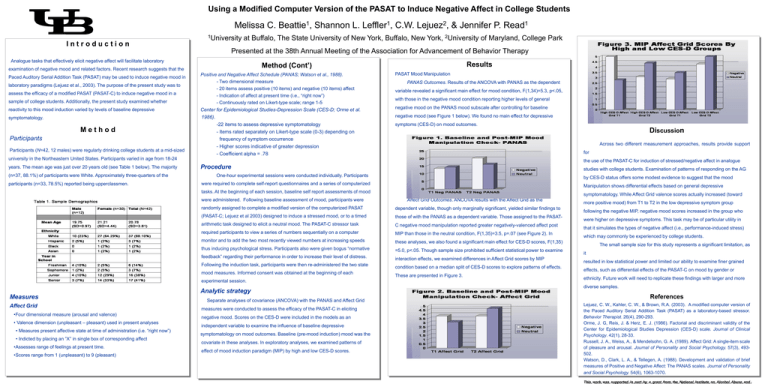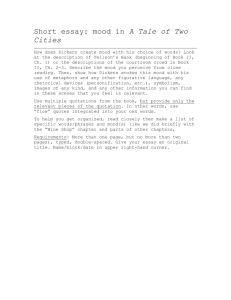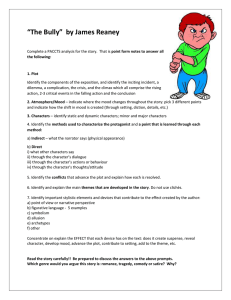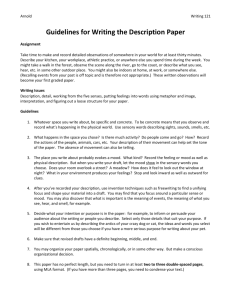Melissa C. Beattie , Shannon L. Leffler , C.W. Lejuez
advertisement

Using a Modified Computer Version of the PASAT to Induce Negative Affect in College Students Melissa C. Beattie1, Shannon L. Leffler1, C.W. Lejuez2, & Jennifer P. Read1 Introduction 1University at Buffalo, The State University of New York, Buffalo, New York, 2University of Maryland, College Park Presented at the 38th Annual Meeting of the Association for Advancement of Behavior Therapy Analogue tasks that effectively elicit negative affect will facilitate laboratory Method (Cont’) examination of negative mood and related factors. Recent research suggests that the Paced Auditory Serial Addition Task (PASAT) may be used to induce negative mood in laboratory paradigms (Lejuez et al., 2003). The purpose of the present study was to Positive and Negative Affect Schedule (PANAS; Watson et al., 1988). - Two dimensional measure - 20 items assess positive (10 items) and negative (10 items) affect - Indication of affect at present time (i.e., “right now”) assess the efficacy of a modified PASAT (PASAT-C) to induce negative mood in a sample of college students. Additionally, the present study examined whether - Continuously rated on Likert-type scale; range 1-5 Results PASAT Mood Manipulation PANAS Outcomes. Results of the ANCOVA with PANAS as the dependent variable revealed a significant main effect for mood condition, F(1,34)=5.3, p<.05, with those in the negative mood condition reporting higher levels of general reactivity to this mood induction varied by levels of baseline depressive Center for Epidemiological Studies-Depression Scale (CES-D; Orme et al. negative mood on the PANAS mood subscale after controlling for baseline symptomatology. 1986). negative mood (see Figure 1 below). We found no main effect for depressive Method Participants Participants (N=42, 12 males) were regularly drinking college students at a mid-sized -22 items to assess depressive symptomatology symptoms (CES-D) on mood outcomes. Discussion - Items rated separately on Likert-type scale (0-3) depending on frequency of symptom occurrence Across two different measurement approaches, results provide support - Higher scores indicative of greater depression for - Coefficient alpha = .78 university in the Northeastern United States. Participants varied in age from 18-24 years. The mean age was just over 20 years old (see Table 1 below). The majority (n=37, 88.1%) of participants were White. Approximately three-quarters of the participants (n=33, 78.5%) reported being upperclassmen. the use of the PASAT-C for induction of stressed/negative affect in analogue Procedure studies with college students. Examination of patterns of responding on the AG One-hour experimental sessions were conducted individually. Participants by CES-D status offers some modest evidence to suggest that the mood were required to complete self-report questionnaires and a series of computerized Manipulation shows differential effects based on general depressive tasks. At the beginning of each session, baseline self report assessments of mood were administered. Following baseline assessment of mood, participants were dependent variable, though only marginally significant, yielded similar findings to (PASAT-C; Lejuez et al 2003) designed to induce a stressed mood, or to a timed those of with the PANAS as a dependent variable. Those assigned to the PASAT- arithmetic task designed to elicit a neutral mood. The PASAT-C stressor task C negative mood manipulation reported greater negatively-valenced affect post required participants to view a series of numbers sequentially on a computer MIP than those in the neutral condition, F(1,35)=3.5, p=.07 (see Figure 2). In monitor and to add the two most recently viewed numbers at increasing speeds these analyses, we also found a significant main effect for CES-D scores, F(1,35) feedback” regarding their performance in order to increase their level of distress. Following the induction task, participants were then re-administered the two state mood measures. Informed consent was obtained at the beginning of each experimental session. Analytic strategy Affect Grid •Four dimensional measure (arousal and valence) • Valence dimension (unpleasant – pleasant) used in present analyses • Measures present affective state at time of administration (i.e. “right now”) • Indicted by placing an ”X” in single box of corresponding affect •Assesses range of feelings at present time. •Scores range from 1 (unpleasant) to 9 (pleasant) Affect Grid Outcomes. ANCOVA results with the Affect Grid as the randomly assigned to complete a modified version of the computerized PASAT thus inducing psychological stress. Participants also were given bogus “normative Measures symptomatology. While Affect Grid valence scores actually increased (toward Separate analyses of covariance (ANCOVA) with the PANAS and Affect Grid measures were conducted to assess the efficacy of the PASAT-C in eliciting negative mood. Scores on the CES-D were included in the models as an independent variable to examine the influence of baseline depressive symptomatology on mood outcomes. Baseline (pre-mood induction) mood was the covariate in these analyses. In exploratory analyses, we examined patterns of effect of mood induction paradigm (MIP) by high and low CES-D scores. =5.0, p<.05. Though sample size prohibited sufficient statistical power to examine interaction effects, we examined differences in Affect Grid scores by MIP condition based on a median split of CES-D scores to explore patterns of effects. These are presented in Figure 3. more positive mood) from T1 to T2 in the low depressive symptom group following the negative MIP, negative mood scores increased in the group who were higher on depressive symptoms. This task may be of particular utility in that it simulates the types of negative affect (i.e., performance-induced stress) which may commonly be experienced by college students. The small sample size for this study represents a significant limitation, as it resulted in low statistical power and limited our ability to examine finer grained effects, such as differential effects of the PASAT-C on mood by gender or ethnicity. Future work will need to replicate these findings with larger and more diverse samples. References Lejuez, C. W., Kahler, C. W., & Brown, R.A. (2003). A modified computer version of the Paced Auditory Serial Addition Task (PASAT) as a laboratory-based stressor. Behavior Therapist. 26(4), 290-293. Orme, J. G, Reis, J. & Herz, E. J. (1986). Factorial and discriminant validity of the Center for Epidemiological Studies Depression (CES-D) scale. Journal of Clinical Psychology. 42(1), 28-33. Russell, J. A., Weiss, A., & Mendelsohn, G. A. (1989). Affect Grid: A single-item scale of pleasure and arousal. Journal of Personality and Social Psychology. 57(3), 493502. Watson, D., Clark, L. A., & Tellegen, A. (1988). Development and validation of brief measures of Positive and Negative Affect: The PANAS scales. Journal of Personality and Social Psychology. 54(6), 1063-1070. This work was supported in part by a grant from the National Institute on Alcohol Abuse and





